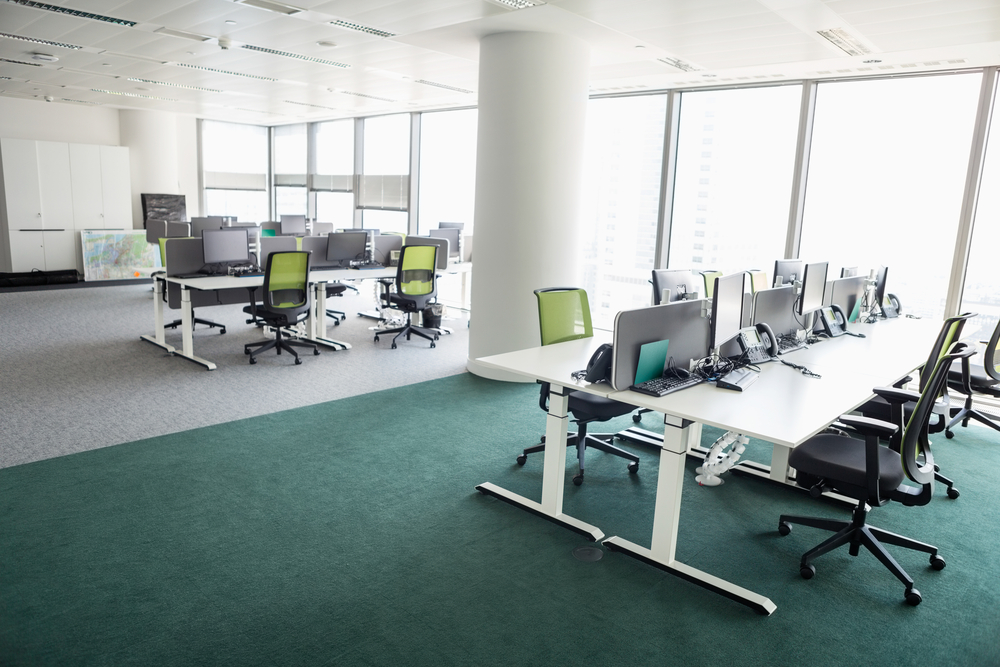
Workplaces are going through an unprecedented shift and restructuring right now, particularly with the flexibility of where people can work from. This has led to some companies going fully remote, some now returning to everyone in person, and some finding a balance between the two. In fact, this isn’t just some companies that have decided that the compromise is what works best — 74% of U.S. companies are switching to a permanent hybrid work model. This has led to many different ideas to optimize this approach to new workplaces, each with pros and cons for factors such as productivity, company culture, overhead costs, and more. One solution that has been gaining traction and capitalizes on the flexibility of working, is called hot desking.
What is hot desking?
Hot desking is a solution that many companies have begun using in their hybrid workplaces to minimize the amount of wasted space from everyone having their own assigned desk. It’s a system where employees don’t have permanent desks and those who are in the office can use any available desks on a first-come, first-served basis. This allows the company to cut back on the number of tables, chairs, equipment, space, and other factors that aren’t necessary if not every employee is coming to the office every day.
How does it work?
As mentioned, this system’s focus is to maximize space and equipment utilization, as well as desk efficiency. For example, take a company that has a hybrid model where its three major teams each come onsite three days per week, but each is given a different combination of days that they come in.
- Team 1 is in the office Monday / Wednesday / Friday
- Team 2 comes in on Tuesday / Thursday / Friday
- Team 3 is in person on Monday / Wednesday / Thursday
This means that on any given day, a maximum of two teams will be in the office (and only one on Tuesdays). If this company chose to adopt a hot desking model, they would be able to reduce the number of desks, real estate, equipment, and more by 33% because the onsite employees would never exceed two teams of the total three. This is immediately an appealing incentive to use hot desking, as it would dramatically cut costs and remove wasted resources that aren’t being used.
Why is it so popular right now?
We mentioned earlier that the rise of the hybrid workplace has been brought on by the flexibility of where employees can work from creating desk and deskless workers. With the popularity of laptop (and even mobile) work, people can work from home, coffee shops, and other locations and have everything they need to be productive without being behind a desk in the office. The pandemic’s impact on this shift is undeniable, and with nearly ¾ of U.S. companies planning on making this permanent, the pressure is on to come up with an affordable model that maintains high productivity. The efficiency and financial appeal of the hot desking model has brought it to the forefront of this new hybrid work and are primarily why it’s gained traction as a permanent solution.
Hot desking vs. hoteling
Before we dive into the pros and cons of hot desking and whether it’s the right fit for your organization, it can often be confused with office hoteling (or desk hoteling). While they are similar concepts, the major difference between the two is that office hoteling involves reserving a desk or seating in advance, rather than showing up and simply finding an available desk for the day. Office hoteling can also involve reserving these workspaces for longer durations, such as several days, a week, or even a month.
Is hot desking right for your organization?
Now that we understand exactly what hot desking is and part of why it’s become so prevalent in hybrid workplaces, we should discuss the major positives and negatives of the model to see if it’s right for your company.
Hot desking benefits
The fact that this model of hybrid work has become so popular is obviously a testament to its benefits. However, several of these advantages really depend not only on your industry, but your organizational structure and individual preferences. Let’s take a closer look:
- Cost savings – as we discussed above, there are multiple ways that hot desking can reduce costs, particularly around things like unfilled desks and rarely used equipment.
- Higher space utilization – related to cost savings is the reduction of real estate needed with fewer people onsite at one time, which increases the utilization rate of that space.
- Maintain collaboration – people can collaborate face to face, rather than constantly needing to email or message each other for all feedback, collaboration, or questions.
- Organized workspaces – with no one being assigned to a particular desk, they don’t get cluttered with stacks of papers, personal items, etc. which create a cleaner workspace.
- Simplicity – hot desking makes it easy for workers to walk into the office and quickly find a spot where they can get to work at, without having to plan or reserve in advance.
- More employee choice/autonomy – hot desking gives people more freedom to choose where they want to work and can boost important factors like employee satisfaction.
- Work frame of mind – it can be difficult to get in a work mindset and stay focused and engaged from home, but hot desking enables this to be done but with more flexibility.
Hot desking drawbacks
Before making a decision about whether hot desking is the right model for your company, the drawbacks and hurdles should also be considered. Again, like the benefits of hot desking, some of these will depend on individual situation and preferences:
- Potential for running out of space – if schedules of who is going to be onsite for which days aren’t planned and followed, there might not be enough desks for the extra people who arrive to work that day.
- Choices can be limited – even if there are enough desks, the available spots might be very limited when some employees show up, leading to frustration, unpredictability, and difficulty seating teams near each other.
- Security concerns – in situations where a company is handling sensitive information or documents, sharing equipment like computers can lead to concerns over the safety of that data and the risk of accidental leaks.
- Health and safety concerns – another downside of several people sharing equipment is the increased danger of quickly spreading germs and illness if everything isn’t properly cleaned after each use (especially with COVID still a concern).
- Lack of personalization – with the cleaner but more empty workspaces and no personal items comes a lack of individual character or decoration of employees’ workstations, which might start to feel boring or dismal.
- Difficult to go back – if an organization commits to hot desking and downsizes their seats, equipment, office space, and more, it would be difficult for them to leave that work model and repurchase everything they would need for all employees to be onsite again.
- Still need to connect everyone – even with employees back in the office for some days, effective connection and collaboration have to bridge the gap from in-person to remote work days, which is where something like an intranet can help. While old intranets were slow, frustrating, and rarely used, next-generation intranet platforms like Igloo connect your workforce through digital workspaces like never before, and amplify what can be done with hot desking and other workplace models.
Improve your hybrid workplace today
Whether hot desking is the right fit for your company or not, chances are high that you will have some remote employees for the foreseeable future. The hybrid model has clearly been the top choice for organizations that don’t require in-person work, and some companies have even opted to continue fully remote. While some have concerns about productivity and collaboration, this can be avoided with a strong digital workspace platform. Not only does it allow you to have the same tools and ability to connect with coworkers no matter where you’re working from, but it strengthens aspects like employee engagement, communication, knowledge sharing and management, and even organizational culture. If you’re ready to upgrade your workplace model to create digital workspaces, learn more or get started today.




